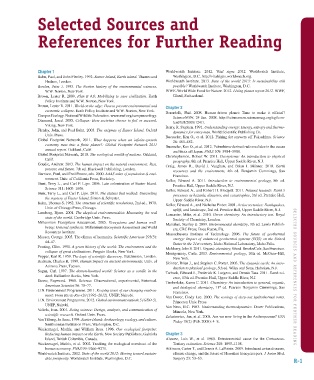Page 740 - Environment: The Science Behind the Stories
P. 740
Selected Sources and
References for Further Reading
Chapter 1 Worldwatch Institute. 2012. Vital signs 2012. Worldwatch Institute,
Bahn, Paul, and John Flenley. 1992. Easter Island, Earth island. Thames and Washington, D.C. http://vitalsigns.worldwatch.org.
Hudson, London. Worldwatch Institute. 2013. State of the world 2013: Is sustainability still
Bowler, Peter J. 1993. The Norton history of the environmental sciences. possible? Worldwatch Institute, Washington, D.C.
W.W. Norton, New York. WWF–World Wide Fund for Nature. 2012. Living planet report 2012. WWF,
Brown, Lester R. 2009. Plan B 4.0: Mobilizing to save civilization. Earth Gland, Switzerland.
Policy Institute and W.W. Norton, New York.
Brown, Lester R. 2011. World on the edge: How to prevent environmental and Chapter 2
economic collapse. Earth Policy Institute and W.W. Norton, New York. Berardelli, Phil. 2008. Human-driven planet: Time to make it official?
Campus Ecology. National Wildlife Federation. www.nwf.org/campusecology. ScienceNOW. 24 Jan. 2008. http://sciencenow.sciencemag.org/cgi/con-
Diamond, Jared. 2005. Collapse: How societies choose to fail or succeed. tent/full/2008/124/1.
Viking, New York. Berry, R. Stephen. 1991. Understanding energy: Energy, entropy and thermo-
Flenley, John, and Paul Bahn. 2003. The enigmas of Easter Island. Oxford dynamics for every man. World Scientific Publishing Co.
Univ. Press. Buesseler, Ken O., et al. 2012. Fishing for answers off Fukushima. Science
Global Footprint Network, 2011. What happens when an infinite-growth 26: 480–482.
economy runs into a finite planet?: Global Footprint Network 2011 Buesseler, Ken O., et al. 2012. Fukushima-derived radionuclides in the ocean
annual report. Oakland, Calif. and biota off Japan. PNAS 109: 5984–5988.
Global Footprint Network, 2010. The ecological wealth of nations. Oakland, Christopherson, Robert W. 2011. Geosystems: An introduction to physical
Calif. geography, 8th ed. Prentice Hall, Upper Saddle River, N.J.
Goudie, Andrew. 2013. The human impact on the natural environment: Past, Craig, James R., David J. Vaughan, and Brian J. Skinner. 2010. Earth
present, and future. 7th ed. Blackwell Publishing, London. resources and the environment, 4th ed. Benjamin Cummings, San
Harrison, Paul, and Fred Pearce, eds. 2000. AAAS atlas of population & envi- Francisco.
ronment. Univ. of California Press, Berkeley. Keller, Edward A. 2011. Introduction to environmental geology, 8th ed.
Hunt, Terry L., and Carl P. Lipo. 2006. Late colonization of Easter Island. Prentice Hall, Upper Saddle River, N.J.
Science 311: 1603–1606. Keller, Edward A., and Robert H. Blodgett. 2011. Natural hazards: Earth’s
Hunt, Terry L., and Carl P. Lipo. 2011. The statues that walked: Unraveling processes as hazards, disasters, and catastrophes, 3rd ed. Prentice Hall,
the mystery of Easter Island. Simon & Schuster. Upper Saddle River, N.J.
Kuhn, Thomas S. 1962. The structure of scientific revolutions, 2nd ed., 1970. Keller, Edward A., and Nicholas Pinter. 2001. Active tectonics: Earthquakes,
Univ. of Chicago Press, Chicago. uplift, and landscape, 2nd ed. Prentice Hall, Upper Saddle River, N.J.
Lomborg, Bjorn. 2001. The skeptical environmentalist: Measuring the real Lancaster, Mike, et al. 2010. Green chemistry: An introductory text. Royal
state of the world. Cambridge Univ. Press. Society of Chemistry, London.
Millennium Ecosystem Assessment. 2005. Ecosystems and human well- Manahan, Stanley E. 2009. Environmental chemistry, 9th ed. Lewis Publish-
being: General synthesis. Millennium Ecosystem Assessment and World ers, CRC Press, Boca Raton, Fla.
Resources Institute. Massachusetts Institute of Technology. 2006. The future of geothermal
Musser, George. 2005. The climax of humanity. Scientific American 293(3): energy: Impact of enhanced geothermal systems (EGS) on the United
44–47. States in the 21st century. Idaho National Laboratory, Idaho Falls.
Ponting, Clive. 1991. A green history of the world: The environment and the McMurry, John E. 2011. Organic chemistry, 8th ed. Brooks/Cole, San Francisco.
collapse of great civilizations. Penguin Books, New York. Montgomery, Carla. 2013. Environmental geology, 10th ed. McGraw-Hill,
Popper, Karl R. 1959. The logic of scientific discovery. Hutchinson, London. New York.
Redman, Charles R. 1999. Human impact on ancient environments. Univ. of Skinner, Brian J., and Stephen C. Porter. 2003. The dynamic earth: An intro-
Arizona Press, Tucson. duction to physical geology, 5th ed. Wiley and Sons, Hoboken, N.J.
Sagan, Carl. 1997. The demon-haunted world: Science as a candle in the Tarbuck, Edward J., Frederick K. Lutgens, and Dennis Tasa. 2011. Earth sci-
dark. Ballantine Books, New York. ence, 13th ed. Prentice Hall, Upper Saddle River, N.J. SELECTED SOUR CES AND REFERENCES FOR FURTHER READING
Siever, Raymond. 1968. Science: Observational, experimental, historical. Timberlake, Karen C. 2011. Chemistry: An introduction to general, organic,
American Scientist 56: 70–77. and biological chemistry, 11 ed. Pearson Benjamin Cummings, San
th
U.N. Environment Programme. 2011. Keeping track of our changing environ- Francisco.
ment: From Rio to Rio+20 (1992–2012). UNEP, Nairobi. Van Dover, Cindy Lee. 2000. The ecology of deep-sea hydrothermal vents.
U.N. Environment Programme. 2012. Global environment outlook 5 (GEO-5). Princeton Univ. Press.
UNEP, Nairobi. Van Ness, H.C. 1983. Understanding thermodynamics. Dover Publications,
Valiela, Ivan. 2001. Doing science: Design, analysis, and communication of Mineola, New York.
scientific research. Oxford Univ. Press. Zalasiewicz, Jan, et al. 2008. Are we now living in the Anthropocene? GSA
Van Tilburg, Jo Anne. 1994. Easter Island: Archaeology, ecology, and culture. Today 18(2) (Feb. 2008): 4–8.
Smithsonian Institution Press, Washington, D.C.
Wackernagel, Mathis, and William Rees. 1996. Our ecological footprint:
Reducing human impact on the Earth. New Society Publishers, Gabriola Chapter 3
Island, British Columbia, Canada. Alvarez, Luis W., et al. 1980. Extraterrestrial cause for the Cretaceous-
Wackernagel, Mathis, et al. 2002. Tracking the ecological overshoot of the Tertiary extinction. Science 208: 1095–1108.
human economy. PNAS 99: 9266–9271. Atkinson, Carter T., and Dennis A. LaPointe. 2009. Introduced avian diseases,
Worldwatch Institute. 2012. State of the world 2012: Moving toward sustain- climate change, and the future of Hawaiian honeycreepers. J. Avian Med.
able prosperity. Worldwatch Institute, Washington, D.C. Surgery 23: 53–63. R-1
Z07_WITH7428_05_SE_References.indd 1 13/12/14 11:41 AM

